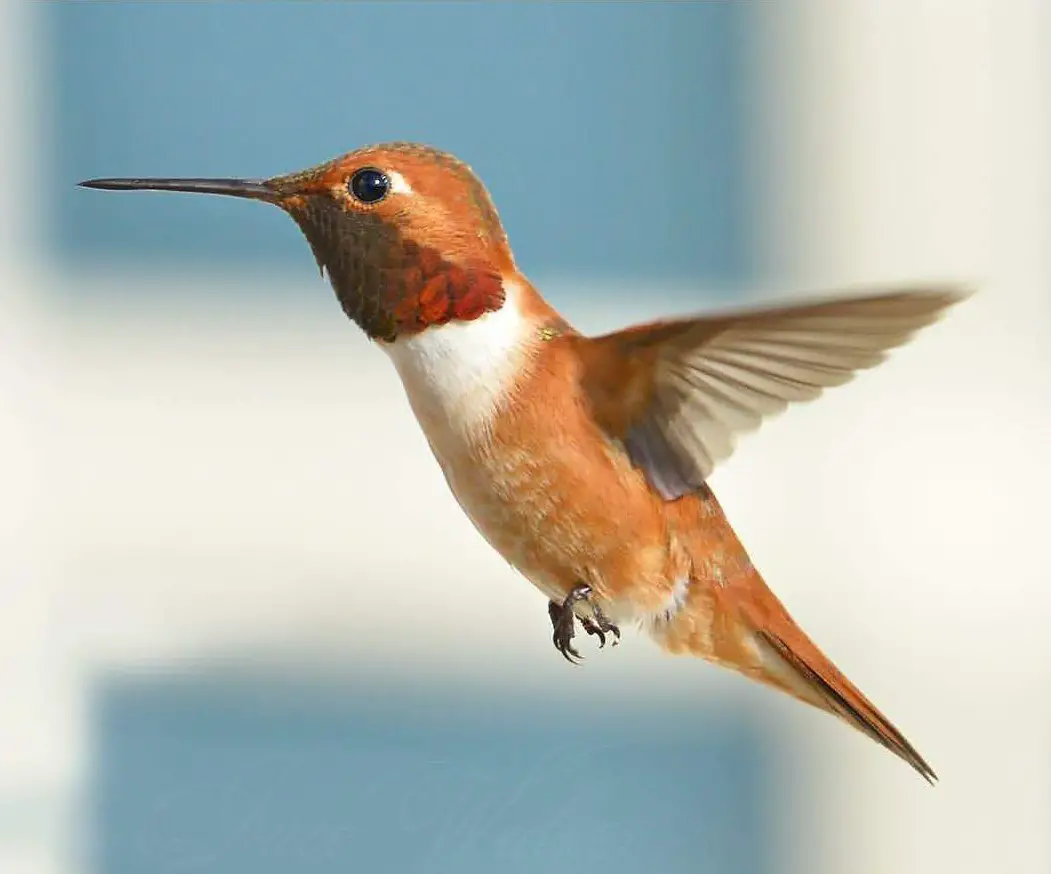This post contains affiliate links.
How fascinating and entertaining it is when a hummingbird zips up to your face and hovers while staring at you quizzically! Engaging in this opportunity allows close contact with these beautiful vibrant creatures.
Have you ever questioned their behavior and wondered what the motives are behind these acts? Are they being aggressive or simply questioning their surroundings? If you are really inquiring, you have chosen the right article.
Why do hummingbirds fly up to your face?
Hummingbirds generally fly up to someone’s face because they are curious or investigating a situation. They are extremely inquisitive about their surroundings and enforce caution and safety in their territory. They also recognize, associate, and expect food from a homeowner when trained to be fed at a feeder.
Hummingbirds are truly remarkable creatures and have a fantastic memory to recall and retain certain patterns about their territory. They are attracted to anything new or out of place which will flag their attention and they will quickly zip over to investigate.
When a hummingbird invades your personal space it is calculating and assessing a situation that may be potentially hazardous to them. Let’s further explore the wonders of these beautiful birds!
Inquisitive Hummingbirds
Hummingbirds are naturally curious creatures. They are always exploring their surroundings to eliminate predators and maintain ownership of their ever-expanding territory of nectar-producing flowering plants and hummingbird feeders.
Hummingbirds are interested in anything that is the color red.
The hummingbird feeders that have worked best for me are the First Nature 16oz feeders.
My hummingbirds empty them in about 36 hours making it difficult for bacteria or fungus to grow before the feeder is ready for cleaning and refill.
The 2 pack is the best to start with, just to help with bullying behaviors, but can also take the pressure off of cleaning and refilling feeders for a continuous nectar supply for your hummingbirds.
In addition to being attractive to my hummingbirds, they are also inexpensive, durable, and more easily cleaned than other inexpensive hummingbird feeders.
For those hummingbird enthusiasts with less hummingbird traffic, I would suggest the Nature’s Way 6oz Mason Jar feeder.
It is glass with a wide mouth and dishwasher safe on the top rack.
I would suggest buying 2 of these glass feeders for the same reasoning as above.
Planting hummingbird nectar-producing plants with red flowers in your backyard landscape along with providing hummingbird feeders with red bases will attract your hummingbird friends. The red bases on hummingbird feeders create the perfect bulls-eye attraction making it easier for a hummingbird to locate their alternate food supply.
Wearing red articles of clothing (like a red shirt or baseball hat) you will find that hummingbirds will hover right in front of you to investigate and cure their curiosity.
Hummingbirds will also gravitate toward pink and purple flower combinations. Any variation or variety of these hues such as salmon, fuchsia, and lilac will attract hummingbirds.
Hummingbirds are not dangerous at all to humans. If you are greeted by a suspicious hummingbird behaving oddly know you have wandered into their territory. Don’t worry for they are on a mission to identify unwanted threats and/or welcome in anticipation of the refilling of their feeding stations.
They Want Food
Hummingbirds are quick aviators and expend tremendous amounts of energy on a daily basis to navigate in the air. Their entire life is spent searching and consuming food in order to survive. They will observe, scope and memorize the various flowers in their territorial area.
Hummingbirds can visit from 1,000 to 2,000 flowers daily in search of food! Their only downfall is that they require a diet of eating every ten minutes to maintain their rapid metabolism.
As they migrate north and south, due to their impeccable memory, they can remember their nectar locations which are extremely convenient and beneficial during their return migration.
Also, local resident hummingbirds that do not migrate south for the winter use their abilities to not only remember their feeding sites but know how long it takes each flower to refill with nectar.
Do Hummingbirds Recognize Certain Humans?
Hummingbirds are hypervigilant observers of their available food sources. They examine and gather information from their environment and instantly notice who is refilling their feeders.
They become extremely familiar with your presence and eagerly await your arrival of a fresh batch of homemade nectar.
Hummingbirds are one of the smartest avian species. For such a tiny bird, their hippocampus is five-times larger than a songbird and is embedded deep in the temporal lobe of the brain. This important structure of the brain is capable of establishing learning and memory. Few birds with this proportionate ratio have comparable levels of intelligence.
Hummingbird enthusiasts will be pleasantly surprised to be greeted by friendly eager hungry visitors.
Providing clean and regularly refreshed hummingbird feeders contribute to the hummingbird’s needs of caloric and nutritional intake to preserve their prosperity and welfare. Hummingbirds are always on the hunt to nourish their depleting fuel supply and will fly right into your face when demanding food! They may even make clicking and chirping sounds to encourage you to refill the feeders.
Hummingbirds are one of the smartest avian species. For such a tiny bird, their hippocampus is five times larger than a songbird and is embedded deep in the temporal lobe of the brain. This important structure of the brain is capable of establishing learning and memory. Few birds with this proportionate ratio have comparable levels of intelligence.
New research has shown that hummingbirds and some other bird species are actually able to recognize the human friends who feed them regularly. They are able to identify and distinguish the differences between a threatening predator and someone who regularly provides them with food.
In fact, these birds are able to make visual and auditory differentiation of individuals. Therefore, the hummingbirds are familiar with your voice, and repeated actions, and recognize your habitual routine. They will feel comfortable in your presence rather than being on high alert.
Are Hummingbirds Dangerous?
Hummingbirds will usually not intentionally hurt or become aggressive towards humans.
If a hummingbird feels threatened in any way they are more likely to flee than fight in a confrontational situation.
There is a minuscule chance that a hummingbird will attack a human.
There is a minuscule chance that a hummingbird will attack a human and only when one gets caught in the crosshairs of an aggressive territorial match, a courtship ritual, or a mother hummingbird protecting her young.
If a hummingbird feels threatened in any way they are more likely to flee than fight in a confrontational situation.
Hummingbirds are dangerous to each other when they become extremely territorial and aggressive as they protect and boast of their food supply to potential mates. During an awkward fight to the death scene, male hummingbirds will engage in combat using their dagger-like beaks and sharp claws to actually stab another male in hopes of winning over a female.
Besides constantly having food on the brain their second goal in life is to procreate. However, once a male impregnates a female, she is the sole caregiver in raising the young until they are three weeks of age.
During this time, she fiercely defends the nest against anyone who could potentially be a threat. The dangers may consist of a human, hummingbirds (male or female) or any other type of bird. Male hummingbirds actually do not participate in the raising of the young. Instead, they immediately go off to find another mate.
Decreasing Hummingbird Aggression
If you recognize a particularly aggressive hummingbird attacking other birds, your pets, or even flying into your face, there are ways to deter their behavior. In order to lower aggression levels in male hummingbirds in your surrounding area, there are some helpful hints to get you started.
Space out your feeders if you have several hummingbirds competing for attention and space in the same area. Feeders that are farther apart increases the physical challenge of the bullying hummingbird to protect their newfound terrain.
While they are zipping from feeder to feeder and expending energy at a rapid rate this allows the less aggressive hummingbirds the ability to eat quietly. This, in turn, will lower the aggression of the more confrontational birds.
Provide and rotate more hummingbird feeders to ensure you are feeding a large number of hungry mouths. Not having enough feeders in your backyard will cause competition and territories that will be threatened. Have enough feeders to keep the hummingbirds in your area well-fed in addition to keeping the bullies at bay and occupied.
When all efforts of controlling aggression are unsuccessful, the simple answer may be the “birds and the bees”. Mother nature and hormones are always hard at work and no human can ever interfere. When two male hummingbirds are vying for the attention of a female, no spacing of feeders or increasing the number of feeders will have an effect on aggressive behaviors during the mating season.
Conclusion
Hummingbirds are naturally curious birds. They constantly question their surroundings and their number one goal every day is continually searching for food. Hummingbirds are interested in everything from a local intruder to discovering a potential mate in their space.
They begin recognizing you as a reliable food supply and may buzz up to your face to greet you while trying to be the first one to a refilled feeder. Hummingbirds are extremely food-oriented but are not dangerous to humans.
Most hummingbirds become aggressive when a male is defending his territory of food or female mothers defending and protecting her babies if they feel threatened.
In order to lower male hummingbird aggression, change or increase the number of available food sources in your area.
Inquisitive hummingbirds are not harmful to humans. Their curiosity simply wants to examine, investigate and secure their bountiful food supply along with attracting potential mates.
Happy Hummingbird Watching!
Backyard Visitors participates in affiliate programs which compensate us for referring traffic.

